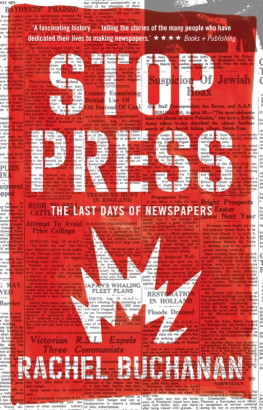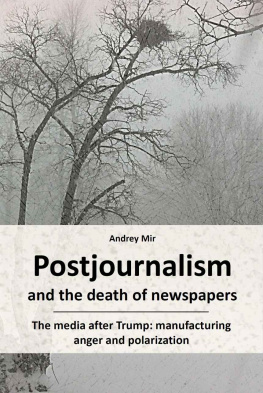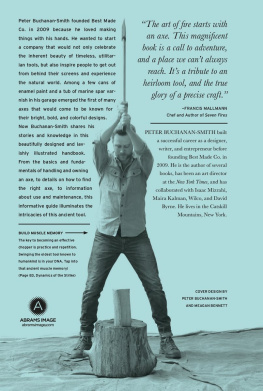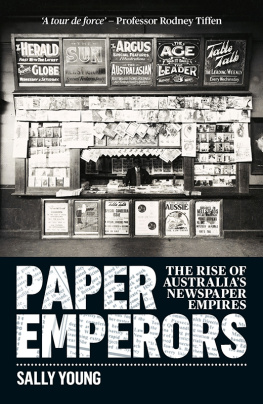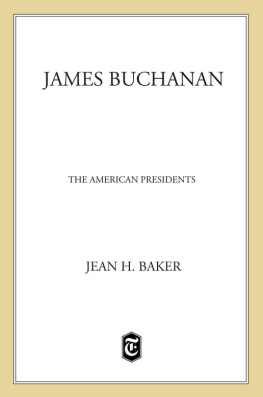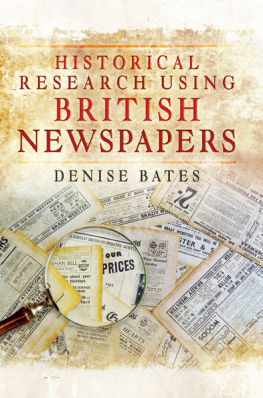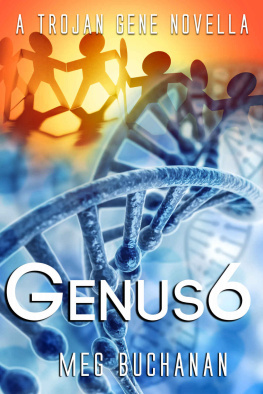
Scribe Publications
STOP PRESS
Rachel Buchanan has worked in New Zealand and Australia for various newspapers, including The Age , as a reporter, feature writer, columnist, and subeditor. Her writing also appears in publications such as Australian Book Review , Meanjin , and Griffith REVIEW . Between 2007 and 2011, she was a lecturer in journalism at La Trobe University in Melbourne. Her first book, based on her history PhD, was The Parihaka Album: Lest We Forget .
Scribe Publications Pty Ltd
1820 Edward St, Brunswick, Victoria 3056, Australia
50A Kingsway Place, Sans Walk, London, EC1R 0LU, United Kingdom
First published by Scribe 2013
Copyright Rachel Buchanan 2013
All rights reserved. Without limiting the rights under copyright reserved above, no part of this publication may be reproduced, stored in or introduced into a retrieval system, or transmitted, in any form or by any means (electronic, mechanical, photocopying, recording or otherwise) without the prior written permission of the publishers of this book.
National Library of Australia
Cataloguing-in-Publication data
Buchanan, Rachel, author.
Stop Press: the last days of newspapers / Rachel Buchanan.
9781922072719 (e-book)
1. PressAustraliaHistory. 2. PressNew ZealandHistory.
3. Newspaper publishingAustraliaHistory. 4. Newspaper publishingNew ZealandHistory. 5. Corporate reorganizationsAustralia. 6. Corporate reorganizationsNew Zealand. 7. Newspaper publishingEconomic aspectsAustralia. 8. Newspaper publishingEconomic aspectsNew Zealand.
079.94
scribepublications.com.au
scribepublications.co.uk
For newspaper people
Contents
Paper girl quits
The sun was just a yellow glow along the hills, and the sky was a very pale blue. It had been cold overnight. The window was damp with dew. The air was still frosty, and my breath fogged the glass. On the horizon, the blue-pink fuzzy line where Cook Strait met the sky, I saw a city sailing out to sea. There were skyscrapers and apartment blocks, car parks and houses, all moving together across the water. In the early-morning haze, this city appeared to float on air. I turned away to put the jug on, and when I looked back the container ship had gone. The dawn city had disappeared. The horizon was so clear it was hard to imagine that there had been anything there at all.
From where I stand, it seems to me that newspapers are much like that city sailing out to sea. They are ghost ships, massive and listing to starboard, the half-full containers carting stories, piloted by hardworking, multinational, skeleton crews of reporters, subeditors, designers, photographers, illustrators, printers, paper-makers, ad reps, ad designers, image processors, cartoonists, truck drivers, and distributors. One morning soon these ships will be gone, and the many thousands of us who have been part of the paper city will have to find another way to make a living.
From adolescence until middle age, I have lived in the dirty, imperfect city of newspapers, first in the Murdoch building and then in the Fairfax one. My debut newspaper story was published when I was 16, for a paper in my hometown in New Zealand. It was about a magician. By 18, I was a netball stringer for three newspapers. At 19, I was given my first job as a reporter. Not long after that, I got my first byline. The story was a human-interest piece about a retired steamboat captain. My surname was there in 10-point Times New Roman upper case, BUCHANAN, but my first name had gone missing. I had a new sex, a new name. I was Richard Buchanan, the junior reporter at the branch office.
In that first year on the job, I went heli-skiing, I parachuted, I flew over film sets, I reported on court and council. I covered an inquiry into jet-boat safety; eight people had been thrown from a boat that hit a bank while it was turning on the Kawarau River, in the South Island. I interviewed the widow and children of soldier Robert Stark, the man who had done the intelligence work leading to an infamous breakout from a prisoner-of-war camp in World War II, as immortalised in The Great Escape (prisoners exited from Stalag Luft III through a tunnel, dug in secret under a wooden gym horse, which acted as an elaborate Trojan Horse). I watched men in black singlets, shorts, and gumboots, and their silky sheepdogs, run down through the snow on Otagos Coronet Peak for the annual dog race.
I had a treatment with an iridologist, who told me that I had toxic red dots in both eyes. She also said that if I rubbed my big toe, I would actually be massaging my brain, and if I rubbed the arch of my foot, I would be kneading my back. I wrote about a couple who had lost 100 kilograms between them on a high-fibre diet they had invented. Before that, they used to eat a pound of butter every week.
I stood in the corner of developers cocktail parties shy, awkward, and critical and watched divorcees chat each other up. It was the mid 1980s, pre-crash, an especially good time to be sleazy, single, and rich. The small tourist town I worked in was being remade in buildings that were pink and grey. Little turrets were popular, and white lattices that sliced courtyards in half. Men wore boat shoes; women, pearls. In that era of ostentatious wealth, even a junior reporter got to eat canaps with the rich.
I hunted for feature stories about people and their lives. I was curious and nave, an unfortunate combination.
One of the men I interviewed that year was a bus driver. He was friendly, the sort who yelled out a cheery hello to passengers, commented on the weather, and wished them a good day as they got off. I used to see him at the pub sometimes with his girlfriend, who was even younger than me; wed have a drink and a bit of a laugh together.
After six months in the job, I went up north to visit my family, and when I got back there were several messages for me from the local police. The bus driver had allegedly shot his girlfriend in the head, and the police had called because of the article Id written. They wanted to ask me what the man was like.
I had to go into the station. The cop showed me photos of the body. He called the girl the de facto, a phrase that was almost a term of abuse back then. He pulled the photos out of a plastic bag, put them on his desk, and asked me some questions. I never wrote about any of it. This disturbing encounter was the first of many in my career that failed to fit either a news-, colour-, or feature-story template and so remained hidden.
I had entered the city of the paper. The world broke over us, and we were supposed to make sense of it with our notebooks and pencils. Newspapers had claimed me; they were a city I could not leave, no matter how hard I tried.
Over the next few years, I did try to leave the industry, consistently. I stayed a year or two in each of my first two newspaper jobs, but by 22 Id had enough and went travelling. Yet I worked for a newspaper in London, too: a local weekly, the North London Advertiser , in Finchley. On the way back to New Zealand, I stopped in Melbourne and fell into casual subediting. I did nights.
After a year of that, I became a general news reporter at The Age . It was stressful. Every day was a competition with other reporters on the paper and on the competitors papers. Each morning the unrelenting cycle would start again, powered by anxiety and fear of failure. Sometimes Id attend an event, a press conference or a protest that was so dull Id sit there in a panic, knowing Id get back to the office and have to make something of it, massage it into a piece of writing that had the elements of a news story: drama, conflict, something new or controversial, a touch of colour. Many of the stories I wrote did not get published or were chopped back to a brief. My days were spent trying to guess what others wanted: the various editors, the readers, the people I was ringing up or going to visit.
Next page
